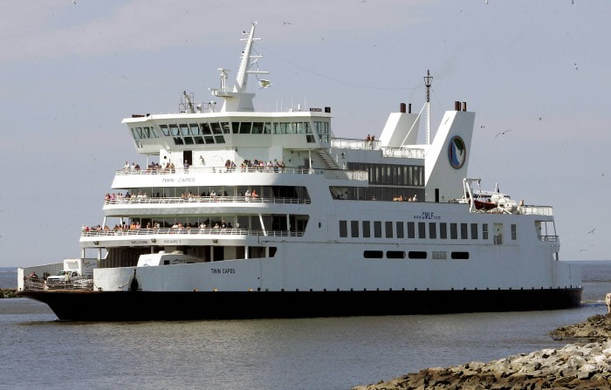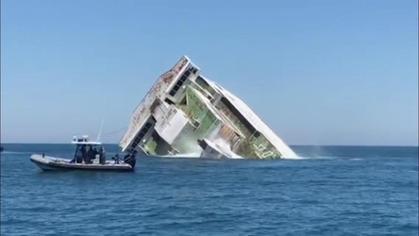Sinking the Twin Capes
By James Donahue
The ferry Twin Capes was part of a fleet of three vessels moving vehicles and people across Delaware Bay for 43 years. Now after its retirement the old ferry has been sunk off the Delaware coast to become the “crowning jewel” in an artificial reef designed to be a habitat for sea life. Thus her years of service will continue on indefinitely.
The 320-foot-long ferry carried more than 45 million passengers and their cars from the day it went into service in 1964. It was removed from service in about 2013 because it was costing too much to run. The ship required 17 crew members to operate and burned 126 gallons of fuel per hour . . . up to 25 percent more than comparable ferries now in operation, the owners said.
The ferry could carry up to 895 passengers and 100 vehicles at a time. It was owned and operated by a two-state agency known as the Delaware River and Bay Authority. It operated as part of Delaware Bay’s Cape May – Lewes Ferry Fleet.
The ferry remained idled for about five years before it was purchased by the Delaware Department of Natural Resources and Environmental Control to be included in the reef project. Coleen Marine of Virginia Beach contracted to prepare the ship and then sink it to its final resting place on the bottom of the Atlantic Ocean. The company scrubbed the ship and removed all toxic substances, including all doors and windows before it was sunk on June 15, 2018.
Twin Capes has now joined several other vessels, including the Coast Guard cutter Zuni/Tamaroa and the USS Arthur W. Radford and USS Gregory Poole. The Twin Capes is now the sixth retired ship to be added to the Del-Jersey-Land reef and other vessels are expected to be added. Also there are over 300 New York City subway cars.
The reef and especially the Twin Capes are expected to provide “extraordinary” opportunities for deep sea diving. The old ships will enhance marine habitats for fish and other sea life, the project promoters say. Reef Coordinator Jeff Tinsman notes that the Twin Capes is expected to be a fine addition to the reef because of the way it is designed.
“The entire vessel has such a high profile that it is going to provide plenty of food for fish to feed on as well as protecting them from predators and storms,” Tinsman said.
Among the types of fish expected to be attracted to the reef are tuna, bluefish, flounder, cod and black sea bass. Even sharks and barracudas may be drawn to the reef.
The reef, which lies about 26 miles southeast of the Indian River inlet, is in water 120 to 130 feet deep.
By James Donahue
The ferry Twin Capes was part of a fleet of three vessels moving vehicles and people across Delaware Bay for 43 years. Now after its retirement the old ferry has been sunk off the Delaware coast to become the “crowning jewel” in an artificial reef designed to be a habitat for sea life. Thus her years of service will continue on indefinitely.
The 320-foot-long ferry carried more than 45 million passengers and their cars from the day it went into service in 1964. It was removed from service in about 2013 because it was costing too much to run. The ship required 17 crew members to operate and burned 126 gallons of fuel per hour . . . up to 25 percent more than comparable ferries now in operation, the owners said.
The ferry could carry up to 895 passengers and 100 vehicles at a time. It was owned and operated by a two-state agency known as the Delaware River and Bay Authority. It operated as part of Delaware Bay’s Cape May – Lewes Ferry Fleet.
The ferry remained idled for about five years before it was purchased by the Delaware Department of Natural Resources and Environmental Control to be included in the reef project. Coleen Marine of Virginia Beach contracted to prepare the ship and then sink it to its final resting place on the bottom of the Atlantic Ocean. The company scrubbed the ship and removed all toxic substances, including all doors and windows before it was sunk on June 15, 2018.
Twin Capes has now joined several other vessels, including the Coast Guard cutter Zuni/Tamaroa and the USS Arthur W. Radford and USS Gregory Poole. The Twin Capes is now the sixth retired ship to be added to the Del-Jersey-Land reef and other vessels are expected to be added. Also there are over 300 New York City subway cars.
The reef and especially the Twin Capes are expected to provide “extraordinary” opportunities for deep sea diving. The old ships will enhance marine habitats for fish and other sea life, the project promoters say. Reef Coordinator Jeff Tinsman notes that the Twin Capes is expected to be a fine addition to the reef because of the way it is designed.
“The entire vessel has such a high profile that it is going to provide plenty of food for fish to feed on as well as protecting them from predators and storms,” Tinsman said.
Among the types of fish expected to be attracted to the reef are tuna, bluefish, flounder, cod and black sea bass. Even sharks and barracudas may be drawn to the reef.
The reef, which lies about 26 miles southeast of the Indian River inlet, is in water 120 to 130 feet deep.

